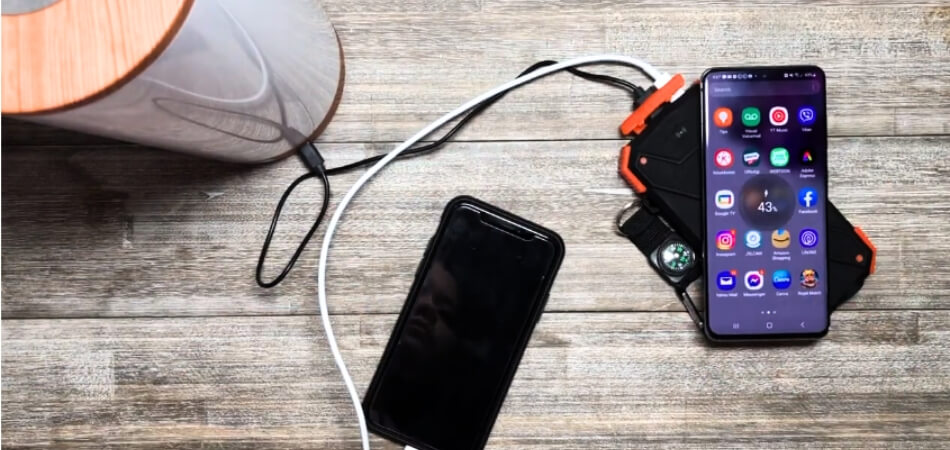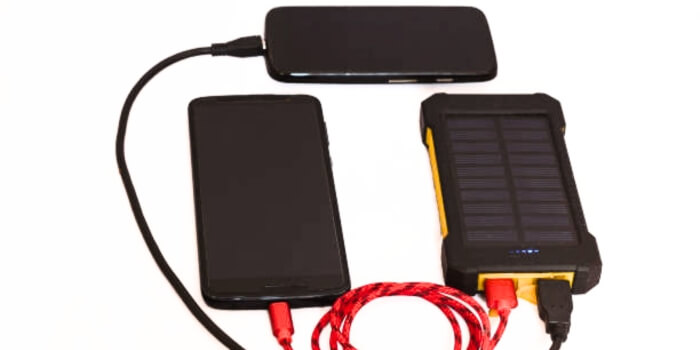The popularity of power banks has soared, becoming an essential accessory for people on the go in recent years. These portable devices store electrical energy and can charge various gadgets, making them indispensable for travelers and outdoor enthusiasts.
But have you ever wondered, “How to charge a solar power bank?”
It's simple! Just place it in direct sunlight or connect it to a USB power source using the provided cable. Ensure the solar panels face the sun for optimal charging.
Curious to learn more? Keep reading as we dive deeper into the world of solar power banks and their charging techniques.
Overview of Solar Power Bank
A solar power bank is a handy device that lets you store electrical energy for later use. It's similar to a regular power bank, but with a cool twist: it can harness energy from the sun!

This feature makes it perfect for outdoor adventures or situations where you might not have access to a power outlet. The solar panels on the power bank absorb sunlight and convert it into electrical energy, which is then stored in the bank's battery.
You can use this stored energy to charge your gadgets, like smartphones, tablets, or cameras, anytime, anywhere. Plus, it's an eco-friendly option, as it relies on renewable solar energy.
So, whether you're hiking, camping, or just spending a day at the beach, a solar power bank ensures your devices stay powered up without needing a traditional power source.
What are the Methods of Charging Solar Power Banks?
It is similar to a breeze while charging a solar power bank and there are a couple of ways to do it. Let's dive into the methods:
Solar Charging
The most obvious method is solar charging. Just place your solar power bank under direct sunlight, and let the built-in solar panels do their magic.
They absorb sunlight and convert it into electrical energy, which is then stored in the power bank's battery. It's a fantastic eco-friendly option, especially when you're out and about in nature.
USB Charging
If you're not in a sunny spot or need a quicker charge, you can always use a USB cable to charge your solar power bank. Just connect it to a computer, a wall charger, or even a ChargeHubGO.
The ChargeHubGO is especially handy because it's a portable charging station that can power up multiple devices at once, including your solar power bank.
Both methods are effective, but solar charging is the way to go if you want to keep things green and use renewable energy. On the other hand, USB charging is perfect for a quick power boost when you're near an electrical source.
How To Charge a Solar Power Bank Using Solar Power?
Charging a solar power bank using solar power is a fantastic way to harness renewable energy and keep your devices powered up while on the go. But you might wonder, “How to charge a solar power bank?”

It's quite simple! Just expose the solar panels to sunlight, and let nature do its work. Let's break down the steps to ensure you get the most out of your solar charging experience.
Step 1: Find the Right Spot
First things first, find a sunny location. Solar power banks need direct sunlight to charge efficiently, so look for a spot where the sun's rays are strong and uninterrupted. Avoid shady areas or places where objects might block the solar panels.
Step 2: Position the Solar Power Bank
Once you've found the perfect spot, position your solar power bank so that its solar panels face directly toward the sun. This ensures maximum exposure to sunlight and optimal charging efficiency.
You might need to adjust the angle of the power bank throughout the day to follow the sun's movement.
Step 3: Monitor the Charging Process
Most solar power banks have indicator lights that show when they're charging and how much power they've stored. Keep an eye on these indicators to monitor the charging process.
Note that charging a solar power bank fully using only solar power can take several hours, depending on the sunlight's intensity and the power bank's capacity.
Step 4: Disconnect When Fully Charged
Once your solar power bank is fully charged, disconnect it from the sunlight. Overcharging can reduce the lifespan of the battery, so it's best to remove it from direct sunlight as soon as it's charged. Store it in a cool, dry place until you're ready to use it.
Step 5: Use the Stored Energy
Now that your solar power bank is charged, you can use it to power your devices. Connect your smartphone, tablet, or other gadgets to the power bank using a compatible cable, and enjoy the convenience of portable power.
Additional Tips
- For the best results, clean the solar panels regularly to remove any dust or debris that might block sunlight.
- If you're in a hurry, you can also charge your solar power bank using a USB cable connected to a power source, like a wall charger or a computer.
By following these steps, you can efficiently charge your solar power bank using the power of the sun. It's an eco-friendly way to keep your devices charged and ready to use, no matter where your adventures take you.
How To Charge a Solar Power Bank Using Electricity?
It is a quick and convenient way to charge your solar power bank using electricity to ensure your portable charger is ready for action.

Whether you're at home or in the office, here's how you can power up your solar power bank using a traditional electrical source.
Step 1: Find the Right Cable
Locate the USB cable that came with your solar power bank. This cable typically has a USB-A connector on one end and a micro-USB or USB-C connector on the other end, depending on your power bank's model.
Step 2: Connect to a Power Source
Plug the USB-A end of the cable into a power source, such as a wall charger, a computer, or a laptop. These devices provide a stable electrical output that's perfect for charging your solar power bank.
Step 3: Connect to the Solar Power Bank
Next, connect the other end of the cable (micro-USB or USB-C) to the input port of your solar power bank. Ensure the connection is secure to ensure efficient charging.
Step 4: Monitor the Charging Process
Keep an eye on the power bank's indicator lights. These lights typically show the charging status and notify you when the power bank is fully charged. Charging times can vary depending on the capacity of your power bank and the power output of your charging source.
Step 5: Disconnect When Fully Charged
Once your solar power bank is fully charged, disconnect it from the power source and the charging cable. It's now ready to provide portable power to your devices whenever you need it.
By following these simple steps, you can easily charge your solar power bank using electricity, ensuring it's always ready to keep your gadgets powered up on the go.
Factors that Determine the Performance of Solar Power Bank
When it comes to solar power banks, their performance can vary based on several factors. Choosing the right one for your needs and ensuring you get the most out of it can be made easier with an understanding of these factors. Here are some key factors that determine the performance of a solar power bank:
- Solar Panel Efficiency: The efficiency of the solar panels on the power bank plays a crucial role. Higher efficiency means more sunlight is converted into electrical energy, leading to faster charging.
- Battery Capacity: The capacity of the power bank's battery, measured in milliampere-hours (mAh), determines how much charge it can store. A higher capacity means it can charge your devices more times before needing a recharge.
- Charge Controller: A good charge controller regulates the flow of electricity from the solar panels to the battery, ensuring optimal charging and preventing overcharging, which can extend the life of the power bank.
- Quality of Materials: The durability and longevity of a solar power bank depend on the quality of materials used in its construction. Look for rugged, weather-resistant designs if you plan to use it outdoors.
- Portability: The size and weight of the solar power bank are important if you plan to carry it around. Compact and lightweight designs are more convenient for travel and outdoor activities.
By considering these factors, you can select a solar power bank that meets your needs and provides reliable performance whenever you need to charge your devices on the go.
FAQs
Charging a solar power bank without sunlight might seem tricky, but it's quite straightforward. Here are some frequently asked questions (FAQs) and their answers to help you understand the process better:
How Do You Charge a Solar Power Bank Without Sun?
If there's no sun, you can still charge your solar power bank using its USB charging port. Simply connect the power bank to a wall adapter or a computer using a USB cable. The electrical energy from these sources will charge the power bank's battery, ensuring it's ready for use when you need it.
Can I Charge My Solar Power Bank Indoors?
Yes, you can charge your solar power bank indoors using artificial light. However, the charging efficiency will be lower compared to direct sunlight. Place the power bank near a bright light source for optimal charging.
How Long Does It Take to Charge a Solar Power Bank Using Electricity?
The charging time depends on the capacity of the power bank and the power output of the charging source. Typically, it takes a few hours to fully charge a solar power bank using a wall adapter or a computer.
Can I Use My Solar Power Bank While It's Charging?
Yes, you can use your solar power bank to charge your devices while it's charging. However, this might slow down the charging process of the power bank itself.
Final Thought
It is a simple process to charge a solar power bank that can be done using sunlight or electricity. Whether you're using solar panels or a USB port, you have to position the power bank correctly and monitor the charging process.
When wondering “How to charge a solar power bank?” Don’t forget that direct sunlight is the most efficient method, but you can also use artificial light or a wall adapter in a pinch.
For better travel experiences, choose a lightweight and durable solar power bank with a high capacity. This way, you can keep your devices powered up and stay connected, no matter where your adventures take you.






